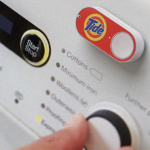The online retailer Amazon made headlines when it introduced a super-inexpensive smart phone from Blu Products in Miami called the R1 HD. The media splash arose because Amazon Prime members could get the phone for as little as $50 if they were willing to put up with seeing ads on the phone’s lock screen.

With high-end phones like the iPhone going for somewhere north of $600, you might wonder what you get in a phone selling for less than one-sixth that amount. It is interesting to make a few basic comparisons with the iPhone 6S. Some of the more notable differences are the processors, memory, and cameras. The Blu phone uses a 1.3 GHz quad-core processor from Mediatek in Taiwan. Meanwhile, the iPhone uses a 1.85 GHz dual-core processor of Apple’s design. The iPhone has twice as much RAM, 2 Gb compared to 1 Gb in the Blu, and 16 Gb of storage compared to 8 Gb in the Blu. But owners can upgrade the Blu to the same amount of memory and storage as the iPhone for only about ten dollars or so.
Both phones have a five-megapixel camera for selfies but the iPhone has a 12-megapixel camera in front compared to an eight-megapixel front camera for the Blu. So the quality of the images isn’t as good on the Blu.
We didn’t try using the phone because we would have had to add a sim card and sign up with a wireless carrier to make use of its features. But reports in the press we’ve seen say the front camera isn’t as good as that on higher end phones. That makes sense in that the Blu camera has only two-thirds as much resolution as those on higher end phones.
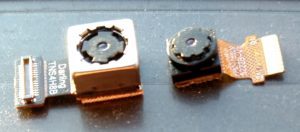
A rule of thumb about cameras is that the deeper the camera body, the better the picture it takes simply because cameras with more depth to them have more room for optical components. With the Blu’s front and back cameras next to each other, it’s easy to see that the selfie camera is shallower than the main camera, meaning it just doesn’t have the same quality of internals.
Removing the back cover
The exterior back of the phone comes off readily, a plus if the phone’s lithium battery ever needs replacement. And the battery has only one connection to the PCB so it detaches easily. The back of the phone case comes off with the removal of a few super tiny torx screws. But there are no facilities for wireless charging in the Blu phone. A lack of wireless charging seems to be part of the price you pay for a cheap smartphone, at least for now.
But once you’re in the phone, you can begin to see why the cost of smartphones has come down. It used to be that smartphones contained two separate CPUs. One would handle the network protocol and the basic functions of a phone. The other would run the user interface and applications. The architecture was as though a PDA, or a personal digital assistant, had been combined with an old-fashioned feature phone. The two processors had a thin communication interface and operated independently of each other.
But the R1 HD we examined has only one processor chip which obviously handles both PDA and phone functions. That chip is what’s called a system-on-chip and it does contain two processors, a quad-core ARM device for phone functions, and a graphics processing unit for the rest of it. And being able to put the two processors in one package is probably part of the reason Blu Products could get the cost of the phone down.
Still, the electronics on this phone layout pretty much the way they do on other smartphones. There are two circuit boards, one in the top of the phone, the other in the bottom. They connect to each other through a flex circuit. The board at the top of the phone contains most of the electronics. The small board at the bottom contains a vibration motor, the microphone, connections for the speakerphone, a USB interface, and part of the antenna. That said, some smartphones won’t use a flex circuit to connect two boards. Instead, they’ll use one circuit board with a section that runs the length of the phone on one side and which connects the upper and lower parts. Finally, there is a wire that connects between the two boards that comprise part of the antenna.
A point of interest is the amount of metal shielding present on both sides of the upper board, and more specifically, how it’s attached. Some of the metal shieldings takes the form of a frame with a detachable lid that pops off. But there are other chips covered by a shield designed to be permanent. And there doesn’t seem to be a rhyme or reason as too why come chips are covered by a removable shield when others aren’t. One might suspect the presence of tunable components under the detachable lids. But we didn’t find any.
Phone architecture
Upon opening the phone case, the first thing visible is the side of the top board containing the SIMs, or the subscriber identity modules, used to identify and authenticate subscribers to a phone network. Also on this side is the LED used for flash photography and as a flashlight. A small metal shield covers some of the circuitry around the LED, including a small 24-pin chip that we can’t identify but which may be some kind of LED driver.
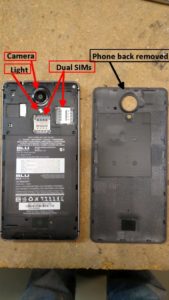
The other side of the board is more interesting. The heart of the design consists of four chips from Mediatek. The main chip is an SoC device dubbed the MT6735. It is a 64-bit quad-core ARM Cortex-A53 processor combined with an ARM Mali-T720 graphics processor, along with several other functions. There are sections of the chip that handle multimedia, the cameras, the display, provide modem functions, and wireless functions.
The modem serves as a means of sending digital data back and forth from the phone when the user does things like internet browsing or email. It’s analogous to the cable modem that brings internet access from cable TV lines. The cable modem is basically a transceiver that decodes internet data from the cable signal and encodes the data going back. The modem in this phone does something similar using either Wi-fi signals, Bluetooth signals, or phone signals.
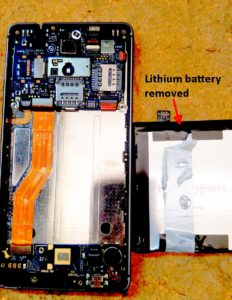
But there’s one aspect of the chip we found to be a bit mysterious. Mediatek says one of the things the SoC handles is connectivity. Specifically, it handles connectivity over Wi-fi, FM radio, GPS, a Russian version of GPS called Glonass, a Chinese version called BDS, and Bluetooth. But the Blu phone also contains a separate Bluetooth chip, the MT6626. So we’re not quite sure what the MT6626 does for a Bluetooth connection if the SoC is supposed to be handling it.
PCB handles power management. Power management chips, or PMICs, on cell phones generally have a lot of features. The Mediatek PMIC on the Blu contains five buck converters, 28 LDOs, drivers for two LED channels, as well as controls for battery charging, the power-up sequence, and a real-time-clock alarm.
Next to the PMIC and the processor chips is a 16-gigabit flash memory chip from SK Hynix in Korea. The processor chip, the PMIC, and the flash memory all sit inside one of the metal shield structures. On the other side of this shielded area is a separate shielded area containing three other big chips and about a dozen tiny ones. The tiny chips don’t contain any definitive markings so we couldn’t identify them.
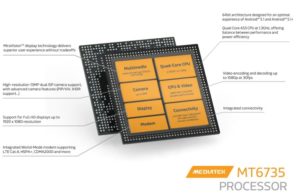
The three big ones, however, were easy to figure out. One is a MediaTek MT6169 RF transceiver. This is the RF chip that works with the data coming in and out of the modem. It supports up to eight primary RF inputs and another eight RF inputs for diversity gains. It works with more than 30 mobile frequency bands and is configurable to handle the standards that prevail in different parts of the world.
There are two other RF chips inside the same metal shield. They’re both from Skyworks, a chip maker in Massachusetts. One is a surface-acoustic-wave filter/directional-coupler RF front end that basically keeps the RF transmissions from the phone from interfering with the reception of the much-weaker RF signals coming from a cell tower.
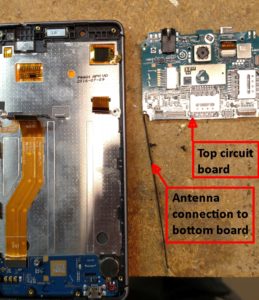
We’d have to say the phone held a few surprises in terms of what we didn’t find on its PCBs. One thing we were looking for was an audio codec for playback and recording of digital audio. But we didn’t find one. It is probably integrated into the SoC.
Another interesting point is that there doesn’t seem to be an antenna switch. This is typically a MEMS SPST switch that lets the antenna handle incoming weak RF as well as the much stronger outgoing transmitter RF by switching back and forth. The fact that the Skyworks SAW filter chip sits right next to the connection for the antenna makes us think it takes the place of the MEMS switch.
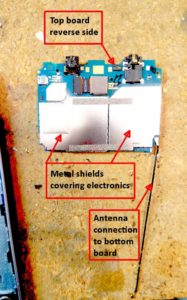
All in all, we can guess about how the Blu can sell in the $50 range while providing many of the functions of phone selling for about five times that amount. In terms of structure and hardware architecture, most smartphones are quite similar. Less expensive models do sacrifice a little resolution in the camera. They might carry slightly less memory but upgrades are generally available for a few extra dollars. There doesn’t seem to be much difference in performance for factors like download and connection speed because the phone network you’re on mainly determines those qualities.
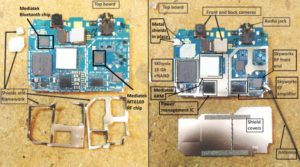
We couldn’t really evaluate the phone’s user interface software, so there may be some differences there. Inexpensive phones don’t provide wireless charging, at least not yet. So if you can live with these limitations, a phone in the $50 range might be OK for you.
The post Teardown: Inside a $50 smartphone, the Blu R1 HD appeared first on Microcontroller Tips.





